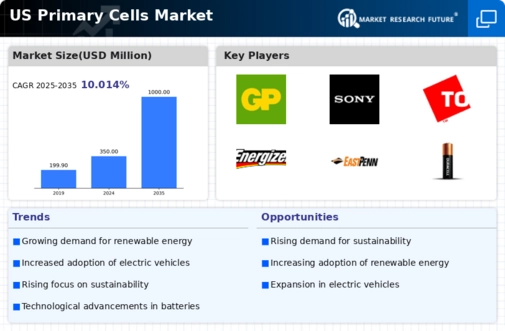Advancements in Consumer Electronics
The proliferation of consumer electronics is significantly impacting the primary cells market. With the increasing adoption of portable devices such as smartphones, tablets, and wearables, the demand for high-performance primary cells is on the rise. In 2025, the consumer electronics sector is projected to account for nearly 40% of the total market share in the primary cells market. This growth is attributed to the need for longer-lasting batteries that can support advanced functionalities in compact devices. As manufacturers strive to enhance battery life and performance, the primary cells market is likely to see substantial innovations and product developments.
Expansion of Electric Vehicle Market
The expansion of the electric vehicle (EV) market is poised to have a profound effect on the primary cells market. As the U.S. government promotes electric mobility through various incentives and infrastructure developments, the demand for efficient energy storage solutions is expected to rise. Primary cells are increasingly being utilized in EV applications, contributing to the overall growth of the primary cells market. With projections indicating that the EV market could grow by over 20% annually, the primary cells market is likely to benefit from this trend, as manufacturers adapt to meet the specific energy needs of electric vehicles.
Growing Awareness of Environmental Impact
There is a rising awareness regarding the environmental impact of energy consumption, which is influencing the primary cells market. Consumers and businesses alike are becoming more conscious of their carbon footprints, leading to a shift towards eco-friendly energy solutions. This trend is prompting manufacturers in the primary cells market to develop products that are not only efficient but also environmentally sustainable. The market is likely to see an increase in demand for recyclable and biodegradable primary cells, which could reshape product offerings and marketing strategies in the coming years.
Rising Demand for Renewable Energy Solutions
The primary cells market is experiencing a notable surge in demand driven by the increasing focus on renewable energy solutions. As the U.S. transitions towards sustainable energy sources, the need for efficient energy storage systems becomes paramount. Primary cells, known for their reliability and efficiency, are being integrated into various renewable energy applications, including solar and wind energy systems. This shift is expected to propel the market, with projections indicating a growth rate of approximately 8% annually over the next five years. The primary cells market is thus positioned to benefit from this trend, as manufacturers innovate to meet the evolving energy storage needs.
Increased Investment in Research and Development
Investment in research and development (R&D) within the primary cells market is becoming increasingly critical. Companies are allocating significant resources to innovate and improve the efficiency and longevity of primary cells. This trend is reflected in the estimated $1 billion investment in R&D initiatives across the sector in 2025. Such investments are aimed at developing new materials and technologies that enhance the performance of primary cells, thereby meeting the growing demands of various applications. As a result, the primary cells market is expected to witness a wave of new products that could redefine energy storage solutions.




















Leave a Comment